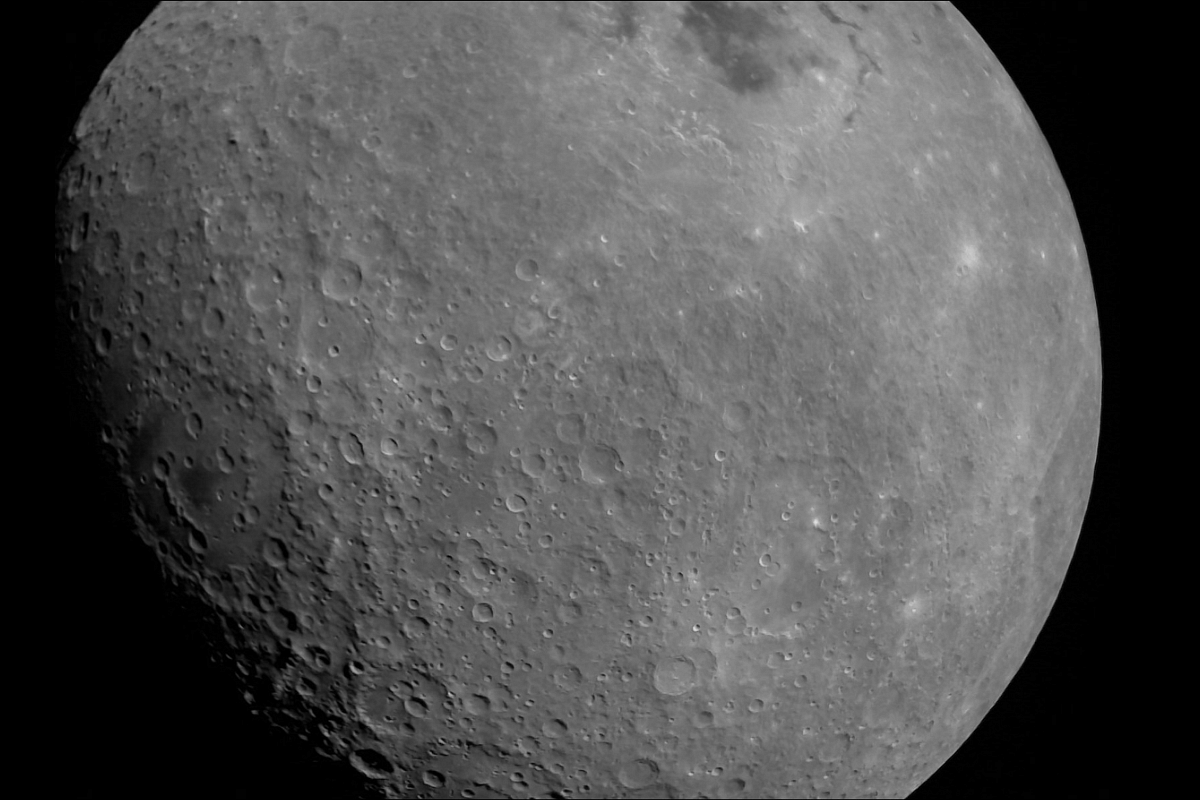Science
ISRO Calls For Proposals From India’s Researchers To Analyse Chandrayaan-2 Orbiter Data
- Indian Space Research Organisation has invited proposals from India's researchers to analyse data coming in from the Chandrayaan-2 orbiter.

Moon as viewed by Chandrayaan-2 LI4 Camera on 21 August 2019 19:03 UT (satellite altitude: ~ 2,650 km)
Indian Space Research Organisation (ISRO) is seeking scientific proposals from the Indian research community for the analysis of data coming in from experiments on board the Chandrayaan-2 orbiter.
The opportunity is open to researchers from India’s academic institutions, universities, colleges, planetariums, and government organisations.
The Chandrayaan-2 orbiter has been in a circular polar orbit around the Moon ever since it got there in September 2019.
India’s second mission to the Moon was launched on 22 July 2019 from India’s spaceport at Satish Dhawan Space Centre, Sriharikota. The orbiter was injected into a lunar orbit on 2 September. It’s been beaming back data ever since.
ISRO has said that its review committee will pick research proposals based on “the novelty of the idea, innovative science and useful output in terms of enhancing scientific knowledge”.
The proposals, though, have to be in line with the capabilities of the payload on Chandrayaan-2. They have to specifically identify and utilise payload data sets for the proposed study.
ISRO has stated that it expects an approved research project to be completed in three years. The principal investigator of the project will have to present the results of the analysis in a science workshop as well as in peer-reviewed journals and conferences or symposiums in India as well as internationally.
Approved projects will receive limited funding towards meeting the salary of a research student, computational facility, contingencies, and for attending project meetings and workshops. The three-year project duration will begin with the release of the fund.
ISRO is encouraging principal investigators to recruit interns — a maximum of three per project for a duration of up to six months — to exclusively analyse Chandrayaan-2 payload data.
The interns, who should be studying in the final year of a Master of Technology or Master of Science programme, may be supported by ISRO through a stipend of up to Rs 10,000 per month.
Project leads will share the progress of their work every year through a report as well as in a workshop held by ISRO.
The Chandrayaan-2 mission brought together an orbiter, lander, and rover to explore the south pole of the Moon. The orbiter was placed in the intended lunar orbit, but the lander was not able to achieve ‘soft’ (controlled) landing on the surface.
The orbiter is expected to operate for seven years and send back important data over its lifetime to enrich our understanding of the Moon.
It has eight payloads in all to carry out remote-sensing observations from a 100 km orbit.
The Orbiter High Resolution Camera is providing high-resolution images of the Moon. The Terrain Mapping Camera 2 is mapping the lunar surface — data from this experiment will offer clues about the evolution of the Moon.
The Chandrayaan 2 Large Area Soft X-ray Spectrometer is there to detect major elements like magnesium, aluminium, silicon, calcium, and titanium by measuring the X-rays they emit when excited by the Sun's rays.
Dual Frequency Synthetic Aperture Radar will help in the quantitative estimation of water-ice in the polar regions.
The other orbiter payloads are Solar X-ray Monitor, Imaging IR Spectrometer (to map the Moon’s mineralogy and confirm the presence of water on the surface), Chandrayaan 2 Atmospheric Compositional Explorer 2 (to study the Moon’s neutral exosphere), and Dual Frequency Radio Science experiment (to study the lunar ionosphere).
Imaging IR Spectrometer data led to unambiguous detection of hydroxyl and water molecules on the surface of the Moon. The study, authored by scientists from different ISRO institutions, was published on 10 August in the journal Current Science.
“The initial data analysis from IIRS clearly demonstrates the presence of widespread lunar hydration and unambiguous detection of OH and H2O signatures on the Moon between 29°N and 62°N lat.,” the study concluded, promising a “much better and complete picture” as more data becomes available.
India’s first lunar mission Chandrayaan-1 had earlier confirmed the presence of water on the Moon with the help of the ISRO and NASA payloads Moon Impact Probe and Moon Mineralogy Mapper respectively.
According to ISRO, studies based on Chandrayaan-1 data have been used to better understand lunar morphology, surface age determination, and composition of the lunar surface, among other things, and expanded the Indian lunar science community.
Data from Chandrayaan-2 was released to the public in two batches on 24 December 2020 and July 2021 respectively. ISRO Science Data Archive holds the data sets acquired from Chandrayaan-2 payloads.
Meanwhile, India is preparing to launch a third mission to the Moon. Chandrayaan-3 is likely to take off during the third quarter of 2022 if “normal work flow” ensues, Science and Technology Minister Dr Jitendra Singh said in a written reply to a question in Lok Sabha on 28 July.
Support Swarajya's 50 Ground Reports Project & Sponsor A Story
Every general election Swarajya does a 50 ground reports project.
Aimed only at serious readers and those who appreciate the nuances of political undercurrents, the project provides a sense of India's electoral landscape. As you know, these reports are produced after considerable investment of travel, time and effort on the ground.
This time too we've kicked off the project in style and have covered over 30 constituencies already. If you're someone who appreciates such work and have enjoyed our coverage please consider sponsoring a ground report for just Rs 2999 to Rs 19,999 - it goes a long way in helping us produce more quality reportage.
You can also back this project by becoming a subscriber for as little as Rs 999 - so do click on this links and choose a plan that suits you and back us.
Click below to contribute.
Latest